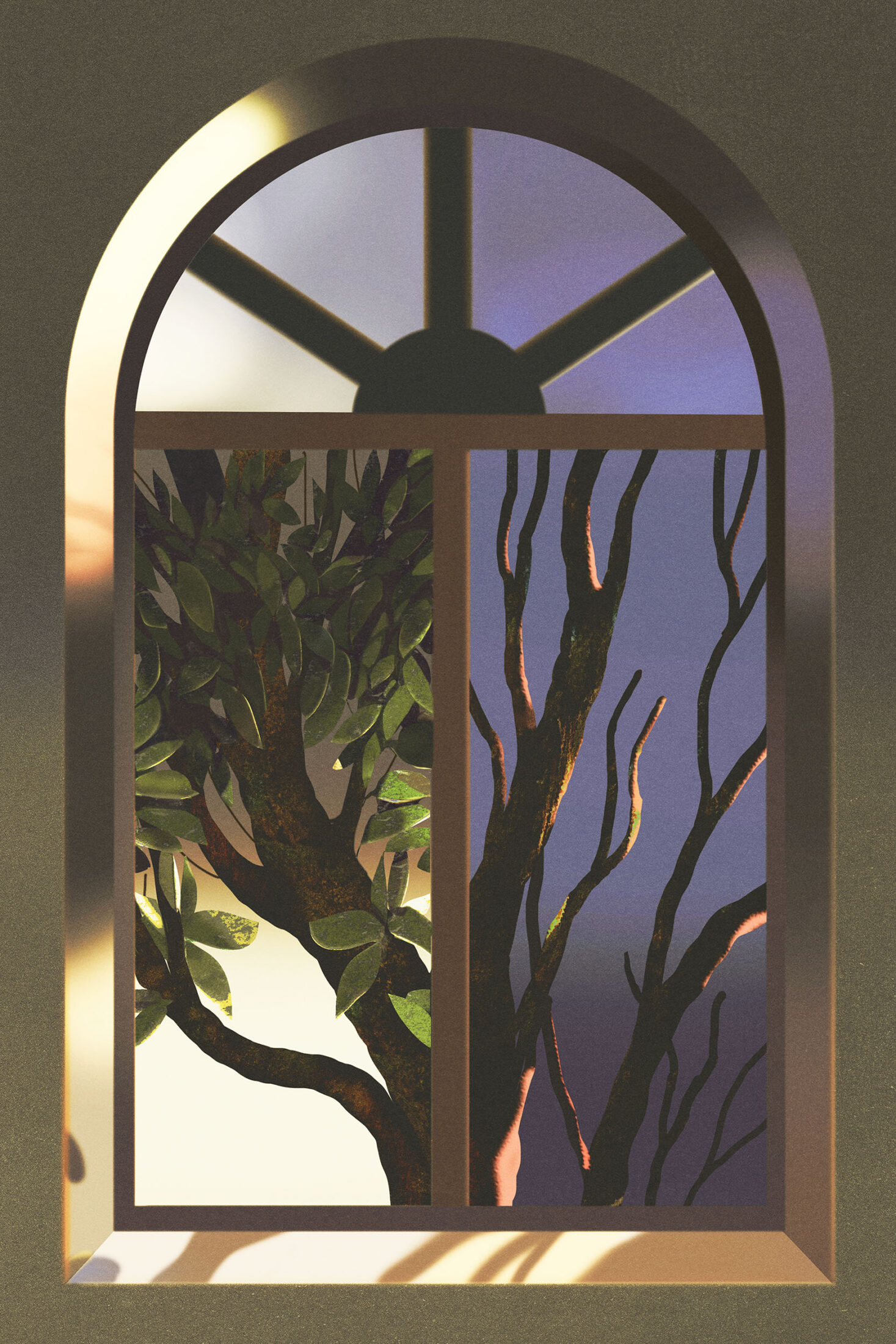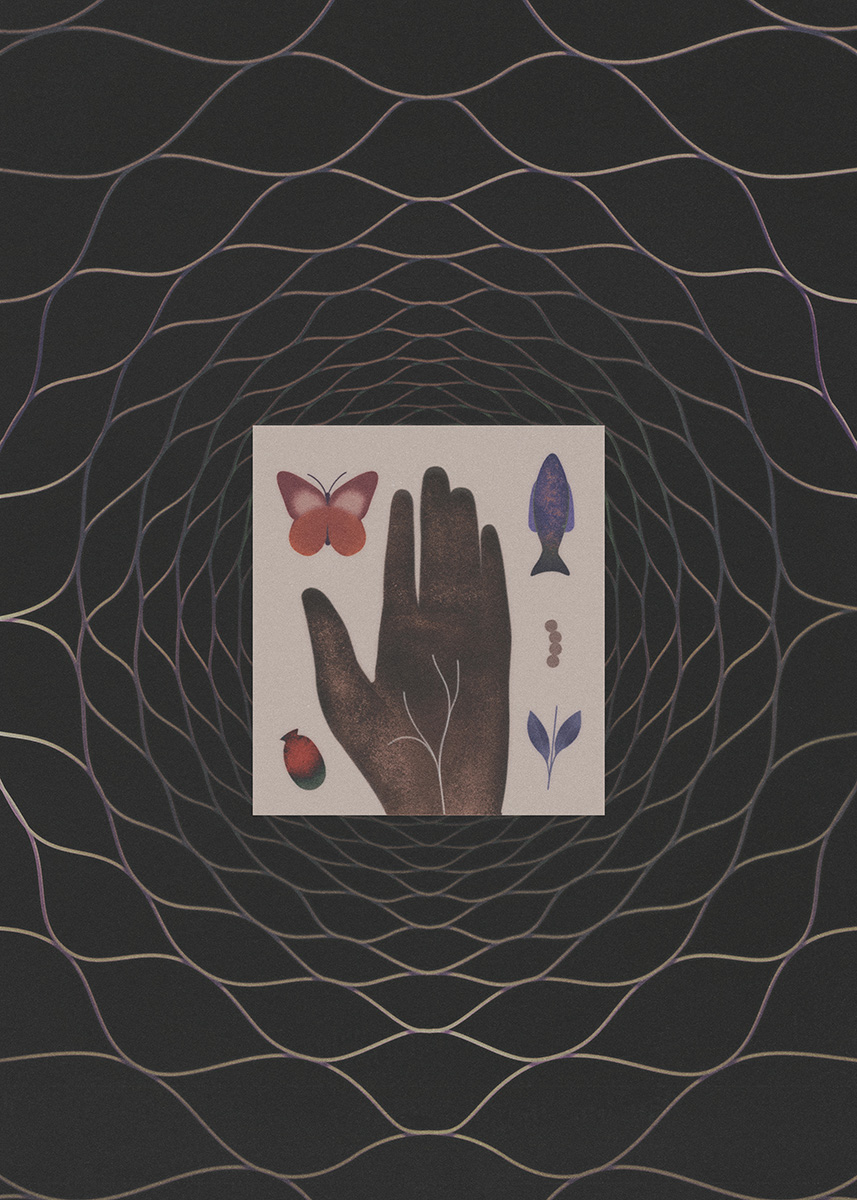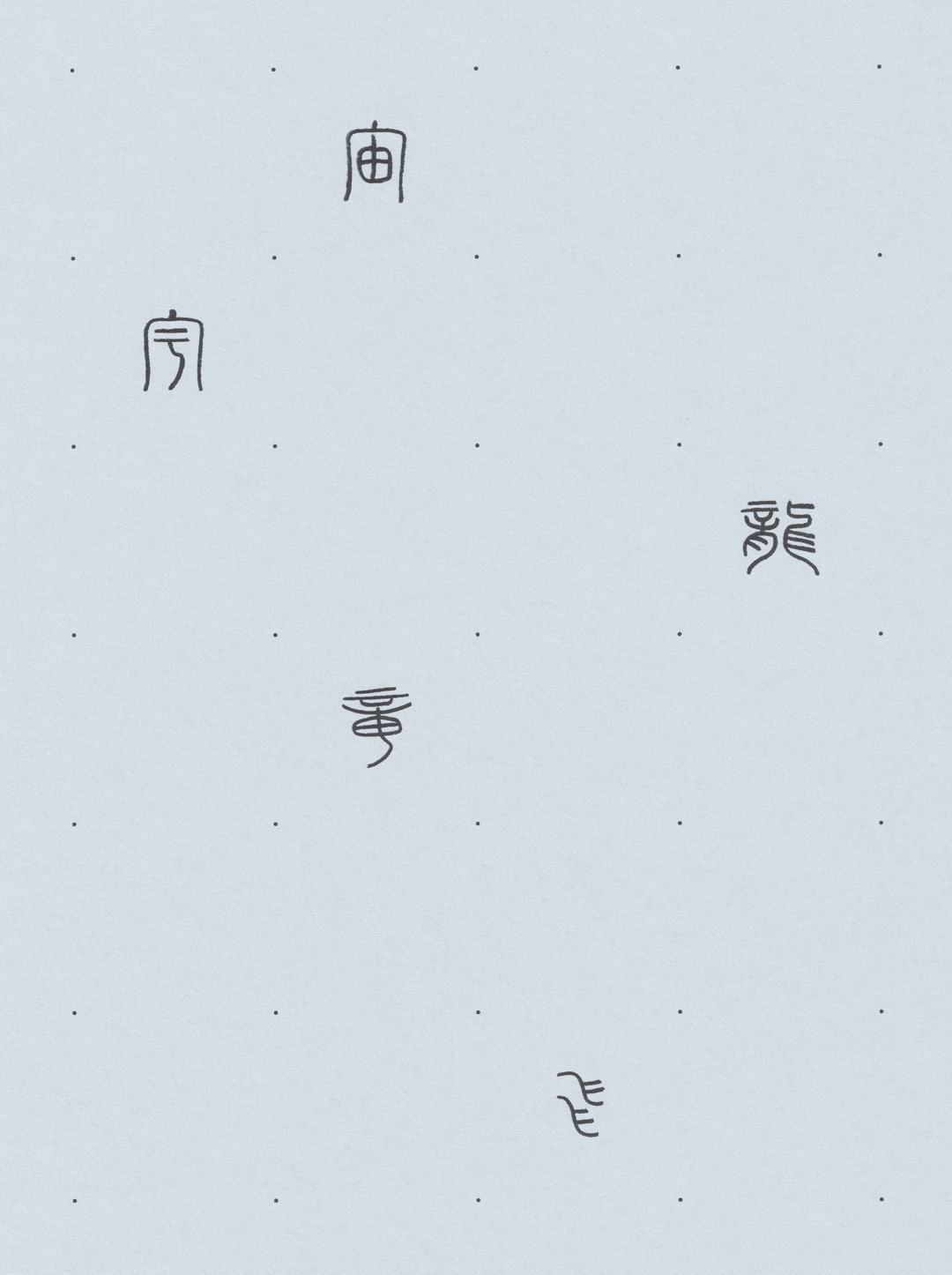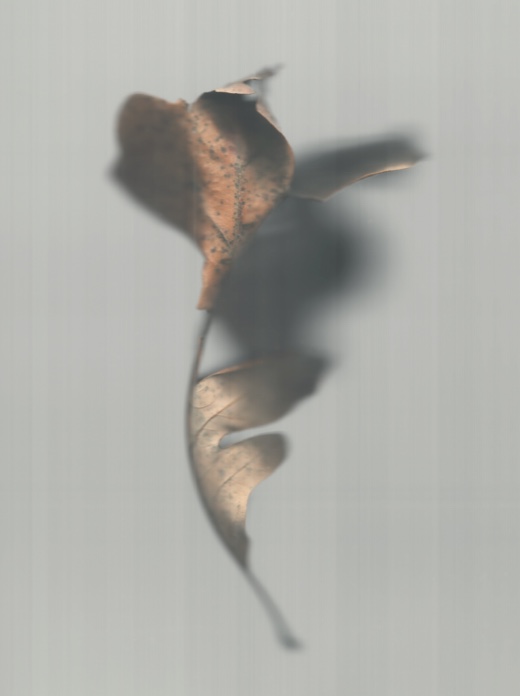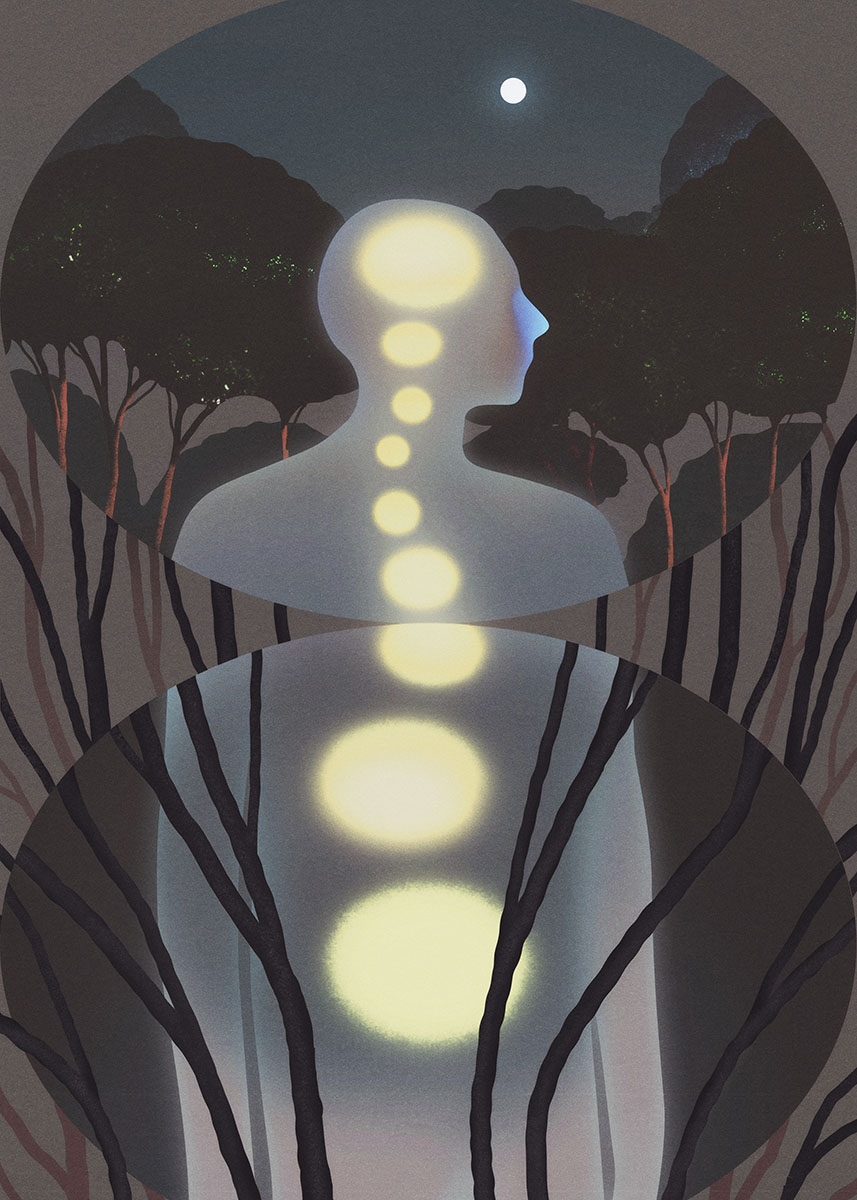
Liam Heneghan is Dublin-born writer living in Chicago. His most recent book is Through Pleated Light: Confessions and Translations. His essays have appeared in Aeon, LA Review of Books, among others.
Ibrahim Rayintakath is an illustrator and art director based in India. His editorial illustrations have appeared in The New Yorker, The New York Times, Wired, NPR, and elsewhere. He lives and works in Ponnani, a small coastal town facing the Arabian Sea.
Ecosystem ecologist Liam Heneghan, keeping vigil by his father’s bedside, glimpses how all life resides in the kingdom of decay.
For all things are from the earth and
all return to the earth in the end.
—Theodoretus, from Treatment of the Greek Conditions
Earth to Earth
1. Before my father’s final illness, I had not understood that when the call goes out to assemble family members dolefully about a deathbed, it’s because a decision has been made to let the loved one pass. The timer is set; the sand is trickling down. Death—that omnipresent possibility at the best of times—becomes calculable when sustenance is withheld. Paddy Heneghan, born in Tralee, Ireland, on 29 March 1927, lived ninety-five years and, though defying predictions by lingering beyond his appointed hour, is now, by all reasonable standards used to determine such matters, dead.1
2. During those nights holding vigil at my father’s hospital bedside, I stayed awake counting his breaths. Human breath, or so Aristotle conjectured, supplies the air—the most divine of the elements—needed to form the pneuma zôtikon, the living spirit.2 I counted as my father’s living spirit—still hitched to his wracked body—was sustained by twelve breaths a minute; seven hundred and twenty ragged breaths an hour. When he breathed a final time—the last of six hundred million by my calculation—I was away. My mother and two siblings were at his side.
3. Years before this, a stroke had left my father alive but greatly diminished. At the Village Coffee Shop, my mother and I drank our cappuccinos and ate our Bakewell tarts, and I said, “It may not seem so yet, but this family has already fallen apart.” Later, Dad would tell me stories, each one polished smooth as a pebble caught in the endless tide. Everything unnecessary is rubbed away. Often it is the same story told in the same way: the waves don’t tire of the same old moon, the same path along the shore.
4. When I returned to my father’s bedside, moments after he’d been pronounced dead, I held his hand in mine; it was still warm. An editorial published in the British Medical Journal in 1895 responding to a spate of anxiety about premature interment vaguely crossed my mind.3 Yes, the editors conceded, there are occasions when syncope, coma, convulsion, hysterical spasm, catalepsy, and exhaustion mimic the death throes. Assuringly, however, medical professionals could always tell when life has truly departed the body. Holding my father’s hand, I could not recall what the true signs of death were.
5. My father was not a man for grasping hands. His expressions of affection took other forms. One morning, after a night of childhood terrors drove me to my parents’ room, I rose to leave the comforts of their bed when my father stirred. His sleeping hand fell across me. I studied it as if it were a stunning natural marvel, which, I suppose, every father’s hand is. As he lay in his casket, I took his hand for the last time. It was so cold. I’d never before known how cold is the lifeless air.
6. What first we learn about fire, philosopher Gaston Bachelard reminds us, is not to touch it.4 Fire, however, was the last element to engage my father’s remains. So hot is a cremation chamber that a body is mostly vaporized rather than burned. Although my father’s milled bones were returned to us, I prefer to think of him in that elemental stream released from Mount Jerome Crematorium, spirited over Templeogue, and carried across the land. Perhaps, a measure of him made it home to Tralee to live on there, bound to the earth of the Maharees.
What Is Life; What Is Death?
7. Impossible to embrace life without gathering an armful of death. I mean this conceptually, definitionally.5 If to define something puts boundaries around that thing, and says “this far but no farther,” then it is clear that life and nonlife are engaged in constant border skirmishes. If fire, for example, isn’t alive, then why do we (in English) insist on “feeding” it?6 If Earth isn’t alive, why call her “mother”? That life at the margins of its definition bleeds into the never-alive should not unnerve us; blurred boundaries also circumscribe philosophy, culture, art, even death itself.7
8. Physicist Erwin Schrödinger’s short book What Is Life? is based on lectures he gave in Dublin in 1943.8 In it he claimed that life’s essential property is its thermodynamic improbability. We should question how life “evades the decay to equilibrium.”9 Why don’t we instantly fall apart? After all, to be consistent with the second thermodynamic law, all things are fated to decay. Schrödinger’s answer to this question is profound and straightforward: organisms maintain a high level of orderliness—low entropy—by continually “sucking orderliness” from their environment. The living and the nonliving are indissolubly linked.
9. On Earth as in the heavens, all things reside in the kingdom of decay—it’s the ineluctable message of thermodynamics. When you chance upon a thing not falling apart, you must ask, “Why not? How are you resisting decay?” When naturalist John Muir wrote that everything is “hitched to everything else in the Universe,” he might have added the less jolly codicil that any well-arrayed thing is twinned to disarray and that disarray is the sibling that pulls the wagon, that constructs the road, and that sets the nose inexorably in the direction of death.10
10. Despite our vaunted bipedality, humans move through the world as if on a horizontal plane, nibbling at the world as we go. To the rear, the vermiform tube of our body emits its rivulet of waste. As with humans, so too with other organisms—the stomatal and the mouthless alike: absorbing order, depositing streams of havoc. In saying that life and environment are indissolubly linked, it’s the equilibration of order and chaos that is meant. Human uniqueness stems not from our being disruptive; rather, it’s the pace and scale of our action that is distinctive.
11. Before James Lovelock speculated about the nature of a homeostatic, life-sustaining, and planetary-scaled entity, that is, about Gaia, he investigated the physical basis of life-detection tests.11 He conjectured that the presence of life on any planet can be confirmed by the “omnipresence of intense orderliness … and of events utterly improbable on a basis of thermodynamic equilibrium.” A source for this suggestion: Erwin Schrödinger’s What Is Life? If Lovelock was correct, then Earth is maintained by the exhalations of all life combined. Earth is ordered on a grander scale than was previously scientifically imagined.12
12. A planet is dead when a steady-state equilibrium is reached for all its chemical potential. On the intimate scale, an organism dies when it ceases to organize its environment and is itself reorganized by its environment. To put the matter differently, an organism or a planet dies when it endures a surfeit of decay over production. Death, like life, is not a matter just for the isolated individual; rather, death is a cosmic affair. For all of that, the moment of death remains both misery and mystery; it is when “the ghost leaves the machine.”13
Love and Strife
13. The pre-Socratic philosophers Leucippus (5th c. BCE) and Democritus (mid-5th–4th c. BCE) conjectured the existence of immutable primary substances—uncuttable elements: the atoms—moving through the void. Changes in plural forms—the compounded multiplicity of nature—stem from the aggregation (growth) of atomic structures and their subsequent dissolution (decay). Later, Empedocles (c. 495–c. 435 BCE) described nature as emerging from opposing processes: “harmonization” into unity and “dissolution” into plurality. The four elements—earth, air, fire, and water—are harmonized by love. Strife is the force of dissolution. One becomes many: things fall apart.
14. “To every thing there is a season,” Ecclesiastes reminds us, “and a time to every purpose under heaven … a time to break down, and a time to build up.”14 This intuition of a harmony between creation and destruction is echoed by Empedocles, who declares that concerning nature a twofold story is told: “At one time, they grew to be one alone out of many, at another again they grew apart to be many out of one.”15 Look for “love” and “strife” under their many names; in the natural order of things, they should achieve a balance.
15. The degree to which, in our modern conception of the cosmos, the forces of order and disorder are balanced is a question best left to physicists. Undoubtedly, we live in a universe where the second law of thermodynamics is inviolate, where the arrow of time is drawn from the quiver of dissolution. On the local scales where you and I operate, we can see creation and destruction play out in fateful ways. We’re born, we endure a bit, and then we die. And as we endure, we atrophy, we resist, we repair, only to succumb.
16. The duality, in our daily lives, of the forces of both aggregation and disaggregation—of love and of strife—are so far-reaching that these tendencies are called by many names. Synonyms for the former include growth, building, constructing, creating, developing, enhancing, expanding, flourishing, improving, proliferating, strengthening, and thriving. Synonyms for the latter include decay, atrophy, corrosion, decomposition, degeneration, destruction, deterioration, disintegration, erosion, moldering, rotting, simplification, and unraveling. Look around you. For each object that comes into view, ask which of these phenomena is in ascendency. What is the state of affairs in your immediate surroundings?
17. A conceptual struggle that is foundational to ancient philosophy remains a contemporary preoccupation: how to reconcile the unity of growth and the plurality ensuing from decay. Does an equity prevail in our intellectual interests concerning these poles? A possible means of quantifying the balance is to trawl the literature of the natural sciences for evidence. Thus, in the titles of scientific papers published from 1975 to the present, I searched for the occurrence of sixteen synonyms of both unity-growth and plurality-decay.16 The stark results: 348,733 papers relate to unity-growth and a mere 44,303 on plurality-decay.
18. A skewed attention among natural scientists to growth is understandable: scientific endeavors are largely pragmatic affairs. But does the neglect of decay extend to other intellectual traditions? It’s not an easy question to answer: the key synonyms I previously used to explore growth and decay are not especially relevant for philosophy, for example. But do ideas of growth and decay not also evoke reflections upon both life and death? Analyzing the publications of biologists reveals that they discuss life twice as much as death. In contrast, philosophers are four times more likely to discuss life.17
A Return to Earth
19. All that flourishes returns to earth. For a short duration, entities are hoisted up upon the world’s thin rind, flourish for their moment, and are promptly resorbed into sediment.18 It’s a lesson I learned young. Although I was not an overly morose child, I inclined in my early attitudes—and later in research endeavors—to decay rather than growth, to the mechanics of decomposition rather than production. Reflecting upon this shadow realm provides, I think, the resources to illuminate one’s daily struggles: from mundane matters to those existential disquietudes that keep us awake at night.
20. We shun death; we shun decay. Even intellectuals may shy away. In the modern university, one finds “life sciences” departments, and even if that faculty fails adequately to capture all life, such departments still aggregate, under the one roof, many of life’s quintessential themes. In contrast, death and decay scurry down far-flung corridors. Morbid themes are discussed, fragmentarily, in psychology, environmental science, philosophy, religious studies, social work, and even literary programs. As a result of this intellectual dispersion, when a loved one dies, I’ve found that the conceptual and spiritual resources were diffuse and inaccessible.
21. For all that, the lessons of decay are all around us: dead bodies, sure, but also leaves, bridges, atomic nuclei, solar systems, cities, friendships, that carton of milk left unattended, the biodiversity of the earth, my aging body, the trellising of my skin, marriages, civilizations both ancient and contemporary, and—driven by the inescapable law of entropic decay—the universe itself hurtles to its heat death when all that is comes into final equilibrium; the cosmos, like an old man sinking finally into his twilight bed, reaches, at long last, a constant uniform temperature.
22. There’s a moment during dissolution when the properties diagnostic of a decaying entity disappear. That once-dark hair is now unambiguously gray; that once-warm hand is cold. On a grander scale, a stressed Earth may lose resilience.19 Such properties of entities not easily traced to those of its parts are termed emergent ones: the whole asserting itself beyond the essential features of the parts. But as things fall apart—when Empedoclean “strife” prevails—what term might we use when the distinctive properties of the whole depart?20 Should these nameless departures not also be given their due?
23. “For dust you are, and to dust you shall return”—thus in Genesis God invites us from the very beginning to keep the decay of the flesh ever close to mind. The “ghost leaves the machine,” the soul departs the body: the essential property seems to be gone. And yet for all that, in decay something always endures. My father’s elements were dispersed to the air; some now have fallen to Earth. I remember that polymathic man, I remember his ceaseless stories, I remember a hand fallen across my body. I remember a father’s care.
24. Each paragraph in this essay is ninety-five words, one word for each of my father’s years on Earth. As I write these final sentences, I am counting down. Sixty-seven words remain, now sixty-four: they slip away almost without my noticing. Only a handful remain. I recollect this: in his final months, as his memories faded, my father would suddenly recall stories from his youth. And not just any stories, but some of the richest, most entertaining stories, ones that had been buried so deep that he thought he’d never find them again. No words remain.21
This essay is part of a series shared in partnership with Center for Humans and Nature, from their five-volume collection, Elementals.
- RIP.ie, “The Death Has Occurred of Patrick Heneghan,” https://rip.ie/death-notice/patrick-heneghan-dublin-templeogue-477614.
- Aristotle, “De Anima,” in The Basic Works of Aristotle, ed. Richard McKeon (New York: Modern Library, 2009).
- “The Signs of Death,” British Medical Journal 2, no. 1813 (1895): 787–88.
- Gaston Bachelard, The Psychoanalysis of Fire (New York: Beacon Press, 1964).
- According to the Clarivate’s Web of Science, since 1975 the number of scientific papers titled “What Is Life?” is 129.
- There are other languages in which it seems that “feeding fire” has its counterpart, but I have not done an exhaustive survey.
- To illustrate this point, one that might not immediately seem intuitive, you might note the number of books and articles entitled “What Is…” (philosophy, culture, art, etc.). In fact, most advocates of major disciplines are embroiled in productive debates about where one discipline ends and another begins.
- Erwin Schrödinger, What Is Life? With Mind and Matter and Autobiographical Sketches (Cambridge: Cambridge University Press, 1992).
- By this poetic phrase, Schrödinger means to compare the vast orderliness of the living entity with the background chemical equilibrium of the universe beyond the vivid entity, an equilibrium that the organism resists for as long as it lives.
- The phrase from Muir is given in several places in his writing, including “My First Summer in the Sierra,” in John Muir: Nature Writings (New York: Library of America, 1997), vol. 2.
- See James Lovelock, “A Physical Basis for Life Detection Experiments,” Nature 207, no. 4997 (1965): 568–70. This work contributed to the development of tests for life deployed by NASA’s Viking program.
- The Gaia hypothesis remains controversial but has persisted and remains influential. The essence of the idea is that each living entity retains its order by exporting disorder, and yet the collective effluxions of organisms exert a homeostatic control on the conditions for life. See James Lovelock, Gaia: A New Look at Life on Earth (Oxford: Oxford University Press, 1979).
- The phrase “ghost in the machine” (used derisively in reference to Cartesian philosophy) comes from Gilbert Ryle, The Concept of Mind (Chicago: University of Chicago Press, 1949). Later, Arthur Koestler made it the title of his 1967 book on psychology and complex systems.
- The translation is from the King James Bible.
- Empedocles fragment 17.1–2. The edition of fragments from the pre-Socratics that I use is Patricia Curd, ed., A Presocratics Reader: Selected Fragments and Testimonia (Indianapolis, IN: Hackett Publishing, 2011).
- The following search terms were used: atrophy, corrosion, decay, decomposition, degeneration, destroy, deterioration, disintegration, dissolution, entropy, erode, erosion, mold, rot, simplify, unravel, build, complex, construct, create, develop, enhance, expand, flourish, growth, improve, order, proliferate, ripe, strengthen, and thrive. In addition to the core terms, variants of the words were investigated (e.g., destroy and destruction, construct and constructions). For this search, the Web of Science Core Collection (1975–) was employed.
- I searched for life and alive, and death and dead, in the papers available on the digital repository JSTOR. The prevalence of these terms among biology and environmental journals versus philosophical journals was used to generate the ratios mentioned in this paragraph. In biology (and environmental) journals, death or dead occurs 322,527 times; alive or life occurred 611,905 times. In philosophy, alive or life occurs in the titles of 3,487 papers, whereas dead or death occurred 913 times. The large difference in the absolute numbers reflect a substantial difference in the numbers of disciplinarily specific journals maintained by JSTOR.
- Energetically, the first five centimeters of soil are the most active components of an ecosystem. See John Aber and Jerry M. Melillo, Terrestrial Ecosystems (Philadelphia: Saunders College Publishing, 1991).
- What I have in mind in using the term resilience is primarily its use in the ecological literature, that is, the capacity of Earth as a system to absorb disturbance without a significant departure from its customary structure and functioning.
- I call those properties that will depart a complex entity during decay—the ones that had formerly been diagnostic ones—Adeiatic properties (from the Greek άδεια).
- In these paragraphs, I used Microsoft Word’s total for each paragraph (excluding associated endnotes and paragraph number).
